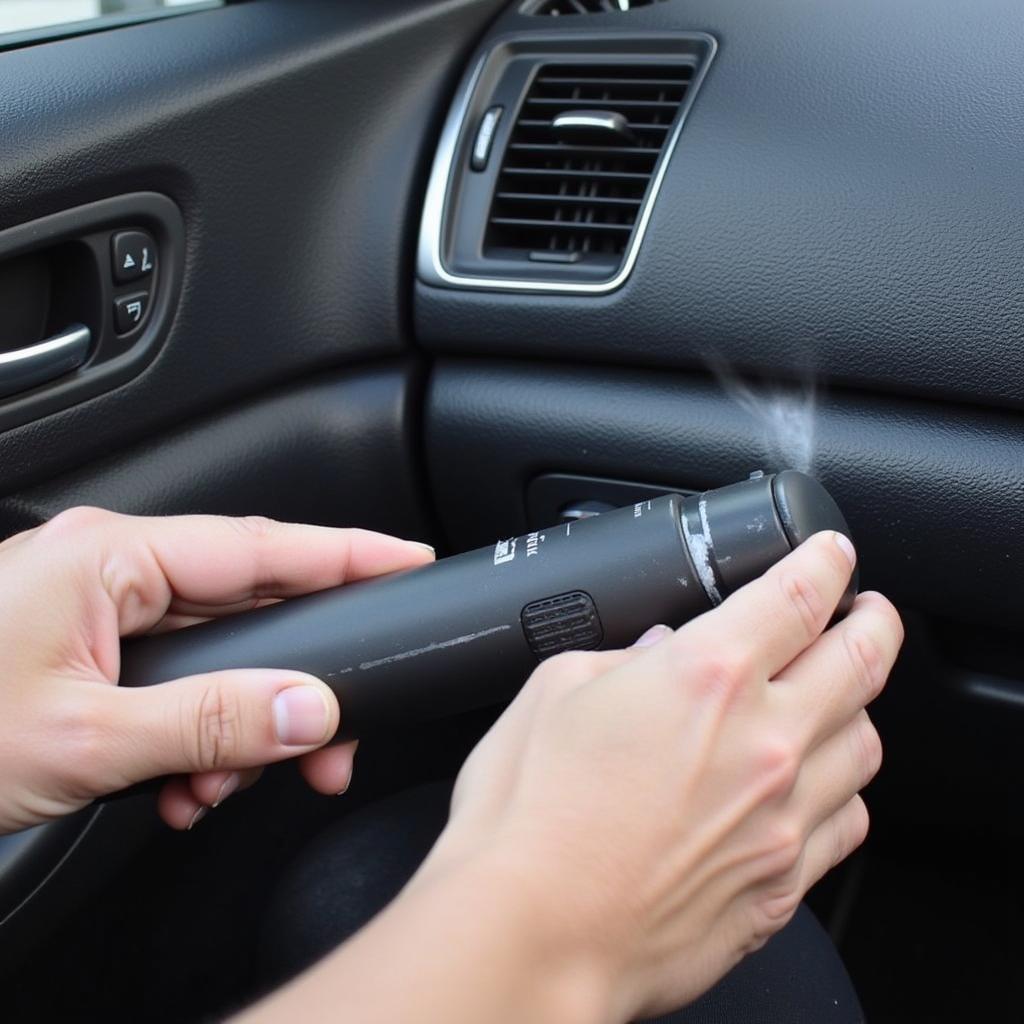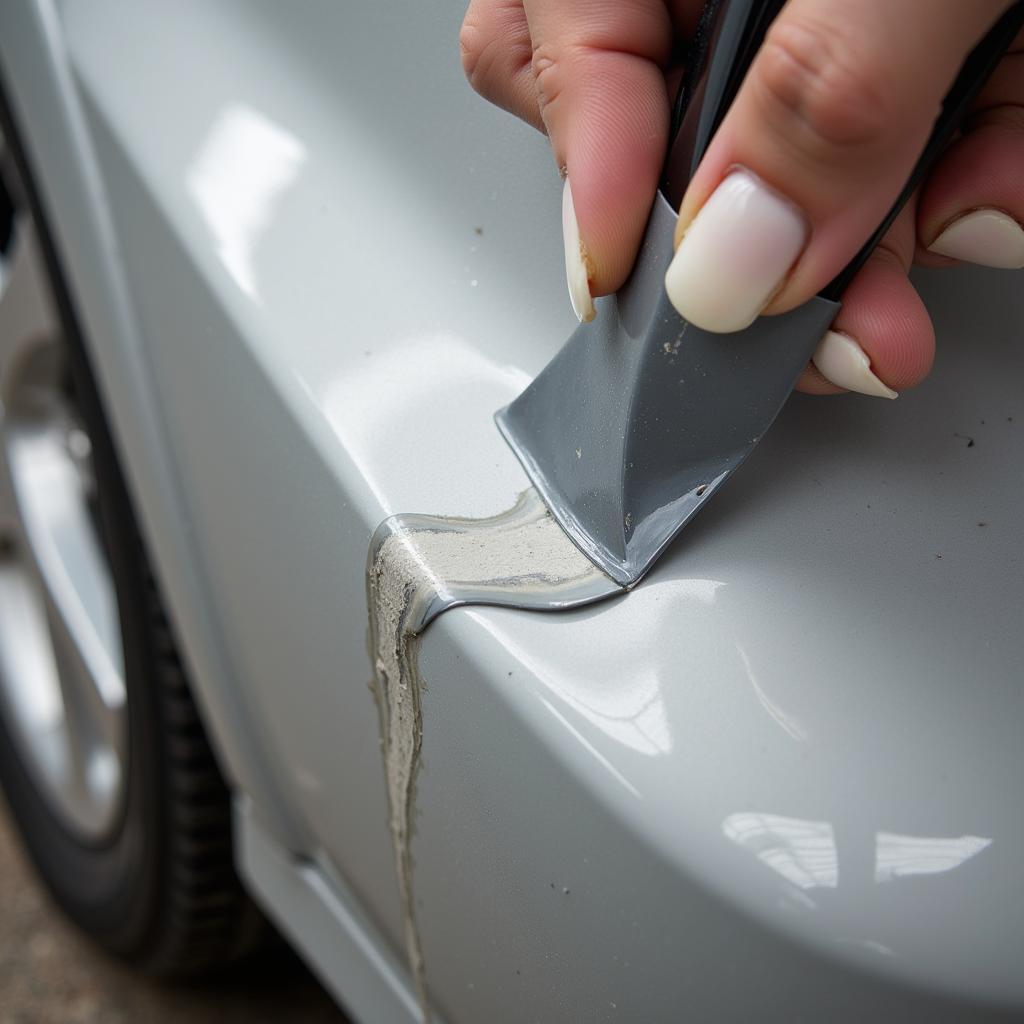Scratched plastic in your car can be an eyesore. Whether it’s on the dashboard, door panels, or exterior trim, these blemishes detract from the overall appearance of your vehicle. Fortunately, fixing scratched plastic on a car is often easier than you think, and you can achieve professional-looking results with a few simple tools and techniques. This comprehensive guide will walk you through the process, from assessing the damage to achieving a flawless finish. Let’s dive in and restore your car’s interior and exterior plastic to its former glory.
 Fixing scratched plastic on a car interior
Fixing scratched plastic on a car interior
Identifying the Type of Scratch
Before you start How To Fix Scratched Plastic On Car, you need to identify the scratch type. This will determine the best course of action. Light scratches and scuffs often respond well to simple cleaning and polishing, while deeper scratches may require more advanced techniques.
Light Scratches and Scuffs
These are superficial blemishes that haven’t penetrated the plastic’s surface. They appear as light, hazy marks and can often be removed with minimal effort.
Moderate Scratches
These scratches are deeper than scuffs and are visible as distinct lines. They haven’t completely broken through the plastic but require more than just cleaning to fix.
Deep Scratches
These are significant gouges that have penetrated the plastic’s surface. They may even expose the underlying material. Repairing deep scratches often involves filling and repainting.
 Repairing deep scratches on car plastic trim
Repairing deep scratches on car plastic trim
Gathering the Necessary Tools and Materials
Having the right tools is crucial for a successful repair. Depending on the scratch’s severity, you’ll need some combination of the following:
- Cleaning Solution: A mild soap and water solution or a dedicated plastic cleaner.
- Microfiber Cloths: Soft and lint-free, ideal for cleaning and polishing.
- Plastic Polish: Specifically designed to restore shine and remove minor imperfections.
- Heat Gun or Hair Dryer: Used for carefully heating and reshaping plastic (for moderate scratches).
- Plastic Filler: Used to fill deep scratches before painting.
- Sandpaper (various grits): For smoothing the filler and preparing for paint.
- Primer and Paint: Color-matched to your car’s plastic trim (for deep scratches).
- Masking Tape: To protect surrounding areas during repairs.
How to Fix Light Scratches on Car Plastic
Fixing light scratches can often be achieved with a simple cleaning and polishing routine:
- Clean the Area: Wash the scratched area with a mild soap and water solution or a dedicated plastic cleaner. Rinse thoroughly and dry with a microfiber cloth.
- Apply Plastic Polish: Using a microfiber applicator pad, apply a small amount of plastic polish to the scratched area.
- Buff the Area: Gently buff the polish in circular motions.
- Wipe Clean: Remove excess polish with a clean microfiber cloth.
For information on fixing scratches on car windows, check out how to fix scratched car window glass.
How to Fix Moderate Scratches on Car Plastic
Moderate scratches require a bit more work, often involving the use of heat:
- Clean the Area: Clean the area as described above.
- Apply Heat: Using a heat gun or hair dryer on a low setting, carefully heat the scratched area. Keep the heat source moving to avoid melting the plastic. You can learn more about bumper repairs at how to fix car bumper.
- Observe the Scratch: As the plastic heats, the scratch should begin to fade. Stop applying heat once the scratch is less visible.
- Cool and Polish: Allow the plastic to cool completely before applying plastic polish and buffing as described above. If you’re interested in other scratch removal methods, how to fix car scratch with wd40 might be helpful.
How to Fix Deep Scratches on Car Plastic
Deep scratches necessitate filling, sanding, and painting:
- Clean and Prepare: Thoroughly clean the area. Lightly sand the scratched area with fine-grit sandpaper to create a better surface for the filler to adhere to. For further advice, you might find anyway of fixing scratched plastic in car useful.
- Apply Filler: Apply plastic filler to the scratch, ensuring it fills the gouge completely and slightly overlaps the surrounding area.
- Sand Smooth: Once the filler dries, sand the area smooth using progressively finer grits of sandpaper.
- Prime and Paint: Apply primer to the filled area and allow it to dry. Then, apply several thin coats of color-matched paint, allowing each coat to dry before applying the next. Also, check out fix scratch interior car plastic for related information.
- Final Polish: After the paint dries completely, polish the area to blend the repair seamlessly with the surrounding plastic.
Expert Insight from Maria Sanchez, Automotive Restoration Specialist: “When dealing with deep scratches, patience is key. Allowing ample drying time for each layer of filler, primer, and paint will ensure a professional-looking finish.”
Conclusion
Fixing scratched plastic on your car can significantly improve its appearance and even increase its resale value. By following the steps outlined in this guide, you can tackle scratches of varying severity and restore your car’s plastic trim to its original condition. Remember to always test any method in an inconspicuous area first. Don’t hesitate to contact Autotippro at +1 (641) 206-8880 or visit our office at 500 N St Mary’s St, San Antonio, TX 78205, United States for any further assistance or guidance on how to fix scratched plastic on car. We’re always happy to help you keep your car looking its best!
Expert Insight from John Ramirez, Lead Technician at AutoTipPro: “Using the right tools and techniques can make all the difference in achieving a seamless repair. Invest in quality materials and follow the instructions carefully for optimal results.”
Expert Insight from David Lee, Automotive Detailing Expert: “Regular cleaning and protecting your car’s plastic surfaces with a UV protectant can prevent future scratches and keep them looking their best.”
FAQ
- Can I use toothpaste to fix scratched plastic on my car? While toothpaste can sometimes help with very light scuffs, it’s not a reliable solution for most scratches and is not recommended for car plastic.
- What is the best type of plastic polish to use? Look for a plastic polish specifically designed for automotive use. These polishes are formulated to restore shine and remove minor imperfections without damaging the plastic.
- How can I prevent future scratches on my car’s plastic? Regularly cleaning and protecting your car’s plastic surfaces with a UV protectant can help prevent future scratches.
- Do I need to sand the plastic before applying polish? For light scratches, sanding is usually not necessary. However, for deeper scratches, sanding is essential for creating a smooth surface for the filler and paint.
- What should I do if the scratch is too deep to fix myself? If you are unsure about tackling a deep scratch yourself, it’s best to consult a professional automotive detailer or body shop.
- Can I use a regular hair dryer instead of a heat gun? A hair dryer can be used for very light scratches, but a heat gun offers more control and is generally recommended for moderate to deep scratches.
- How long does it take for plastic filler to dry? Drying times vary depending on the type of filler and ambient temperature, but it typically takes between 30 minutes and a few hours. Always refer to the manufacturer’s instructions for specific drying times.





Leave a Reply